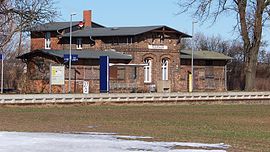Wismar – Rostock railway line
| Wismar – Rostock | |||||||||||||||||||||||||||||||||||||||||||||||||||||||||||||||||||||||||||||||||||||||||||||||||||||||||||||||||||||||||
|---|---|---|---|---|---|---|---|---|---|---|---|---|---|---|---|---|---|---|---|---|---|---|---|---|---|---|---|---|---|---|---|---|---|---|---|---|---|---|---|---|---|---|---|---|---|---|---|---|---|---|---|---|---|---|---|---|---|---|---|---|---|---|---|---|---|---|---|---|---|---|---|---|---|---|---|---|---|---|---|---|---|---|---|---|---|---|---|---|---|---|---|---|---|---|---|---|---|---|---|---|---|---|---|---|---|---|---|---|---|---|---|---|---|---|---|---|---|---|---|---|---|
|
Sandhagen stop (b Bad Doberan)
| |||||||||||||||||||||||||||||||||||||||||||||||||||||||||||||||||||||||||||||||||||||||||||||||||||||||||||||||||||||||||
|
Course of the Wismar – Rostock railway line
| |||||||||||||||||||||||||||||||||||||||||||||||||||||||||||||||||||||||||||||||||||||||||||||||||||||||||||||||||||||||||
| Route number : | 6921 | ||||||||||||||||||||||||||||||||||||||||||||||||||||||||||||||||||||||||||||||||||||||||||||||||||||||||||||||||||||||||
| Course book section (DB) : | 185 | ||||||||||||||||||||||||||||||||||||||||||||||||||||||||||||||||||||||||||||||||||||||||||||||||||||||||||||||||||||||||
| Route length: | 56.6 km | ||||||||||||||||||||||||||||||||||||||||||||||||||||||||||||||||||||||||||||||||||||||||||||||||||||||||||||||||||||||||
| Gauge : | 1435 mm ( standard gauge ) | ||||||||||||||||||||||||||||||||||||||||||||||||||||||||||||||||||||||||||||||||||||||||||||||||||||||||||||||||||||||||
|
|||||||||||||||||||||||||||||||||||||||||||||||||||||||||||||||||||||||||||||||||||||||||||||||||||||||||||||||||||||||||
The Wismar – Rostock railway is a single-track, non-electrified railway line in the north of Mecklenburg-Western Pomerania . It has been connecting the two Hanseatic cities of Wismar and Rostock since 1883 and is now served by regional transport.
history
Wismar-Rostock Railway

As early as the 1830s, the city of Wismar tried to get the fastest possible connection to the emerging German railway network, which it received in 1848 with the line to Schwerin , Rostock followed two years later with a branch line via Bützow to Bad Kleinen . In the years that followed, Mecklenburg's main routes, which are still important today, were built. The construction of branch lines did not begin until the 1880s, including between Wismar and Rostock. On July 19, 1883, the Wismar-Rostock Railway Company was founded by the cities of Rostock and Wismar and the railway company Lenz & Co. The share capital was 2.07 million marks. The route runs almost parallel to the Baltic coast . On July 27, 1883, the Rostock – Doberan section, and the Doberan – Wismar section on December 22 of the same year, was opened to traffic. At the start of operations, the company had four locomotives, seven passenger cars and 25 freight cars. Operating profit in 1888 was around 41% of revenues. The company was nationalized in 1890 and operations were taken over by the Friedrich-Franz-Eisenbahn .
See also: Locomotives of the Wismar-Rostock Railway
State-owned operation
After the establishment of the Deutsche Reichsbahn in 1920, it took over operations on the line. The trains along the route served and still serve primarily local traffic. In the 1930s there were about six to nine trains per day (Kursbuchlinie 118c). After 1945, this situation changed little at first. In the 1970s and 1980s, the range was expanded somewhat. In addition to around nine pairs of continuous passenger trains and a few amplifiers between Kröpelin or Doberan and Rostock, two pairs of express trains ran on the 780 route, but they took around 85 minutes for the almost 57 kilometers. In addition, there was an express train pair Bad Doberan - Wismar - Erfurt for several years in the summer season and, at times, another holiday express train from Wismar via Rostock to Thuringia. In addition, individual express trains from Berlin – Dresden or Magdeburg – Leipzig were tied through via Rostock to Bad Doberan.
In the early 1990s, electrification of the route between Rostock and Bad Doberan was planned. However, due to the turnaround and the decreasing importance of seasonal traffic to Bad Doberan, this project was not implemented. At the end of the 1990s, the line was upgraded to a model branch line with a maximum speed of 80 km / h. A new stop at Rostock Thierfelder Straße was built. During the expansion, the infrastructure was so reduced that passenger trains were canceled for freight traffic and had to be replaced by buses . The electronic interlocking technology is operated from Neuruppin . Since the line was completed in November 2000, the RB 11 line has been running every hour between Wismar, Rostock and Ticino with Desiro vehicles . In addition, the RB 12 runs every hour during rush hour between Rostock and Bad Doberan , which is connected to Graal-Müritz .
In 2009, the state of Mecklenburg-Western Pomerania put out a tender for passenger traffic on the route for the period from December 9, 2012 as part of the Warnow network (together with the Rostock S-Bahn ). DB Regio won this tender. On December 13, 2015, line RE 8 Wismar – Rostock – Ticino became line RB 11 Wismar – Rostock – Ticino.
Trivia
The Rostock Thierfelder Straße stop is written in this form by the railway in all documents, although the corresponding street was named after a person ( Theodor Thierfelder ), and is therefore called Thierfelderstraße.
Web links
- The history of the Mecklenburg Railways (PDF file) (577 kB)
- Route data and operating points on eisenbahn-mv.de
- Neubukower Rübenbahn on stilletzt.de



